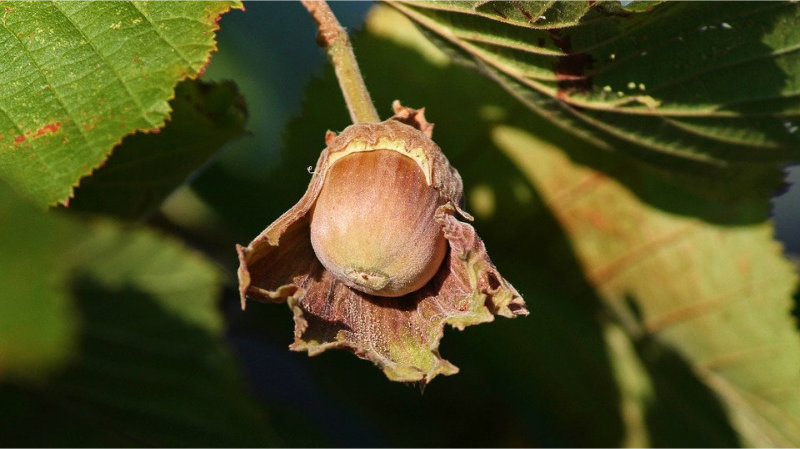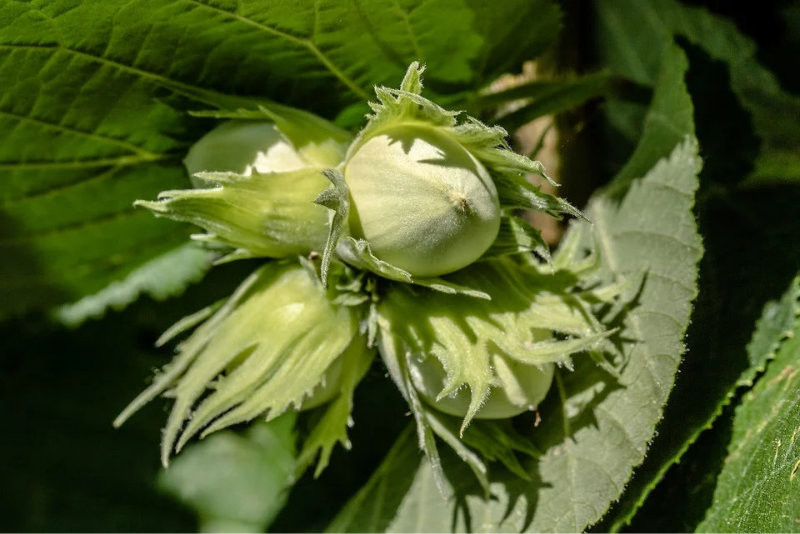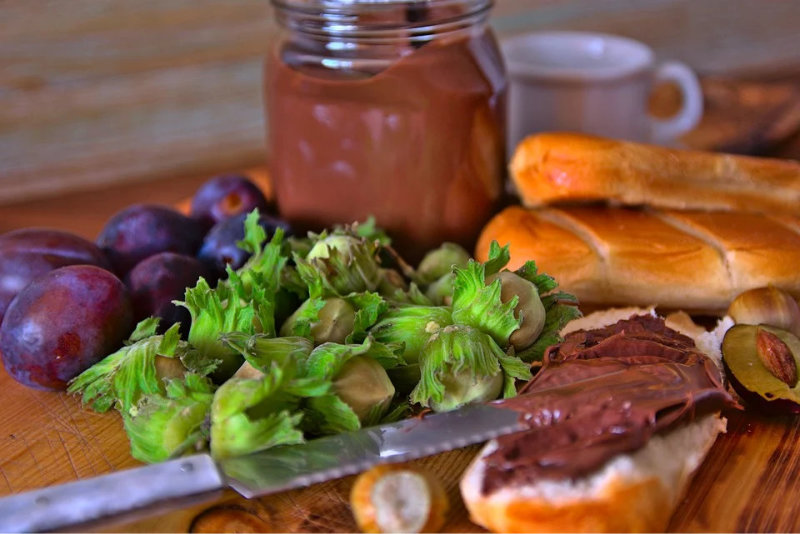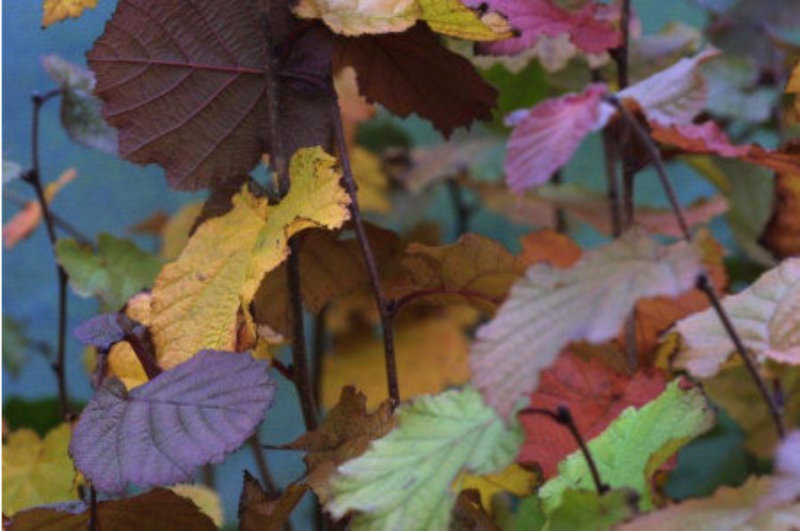What is the difference between a cobnut and a filbert? Are they the same thing, with regional variations of nomenclature?
Is a filbert the fancier version of a cobnut with a longer husk? And how do they relate to hazelnuts? There must be a kernel of truth in there somewhere…

A blank hazelnut just begging for someone to paint a face on it
Kent is where you’ll find the huge majority of cobnut orchards, or ‘plats’. The Kentish Cobnuts Association, which holds events such as the annual Nutters Supper, and has some great recipes, makes no hard distinction between cobnut and filbert. They explain the situation thusly: a cobnut is any cultivated variety of the wild hazelnut, as a Cox apple is a cultivated variety of wild apples, and filberts are a subcategory of cobnuts, as in the Lambert’s Filbert, which the Association considers to be the “true Kentish cobnut”.
But hold on. There are two main species of wild British hazelnut: Corylus avellana and C. maxima. C. avellana is the common hazelnut, whose cultivars are known as cobnuts…except when they are filberts, which are derived from C. maxima, the “other” wild hazelnut. This brings us to the husk. C. maxima produces longer, frilly husks that extend past the nut inside: one etymology for filbert is from the German vollbart, full beard. The other is derived from the feasts of St Philbert (608-684), the Benedictine abbot and bishop, which is on August 20th, and then St Lambert (martyred in 709) on September 17th: traditional hazelnut harvest time, especially back in the medieval warm period that followed a couple of centuries after those saints, when temperatures in Europe were higher than today.

Autumn green hazelnuts
All of which I tried to explain to my sister as we admired a profusely fruiting hazel/cob/filbert/whatever-you-pleasenut in a Cotswolds pub garden a few weeks ago, reminiscing happily on our free-range south Shropshire childhood. The two of us have vivid memories of scouring the local hedgerows for the nuts in early autumn (it’s a race with the squirrels, so you either have to be quick, or learn to make a mean squirrel pie). We would grab them straight from the branch, lifting each other up to reach the higher ones, peel away the fibrous husks and, throwing health and safety to the wind, crack them carefully between our teeth, much to my future dentist’s profit. Depending on luck and the maturity of the nut, you’re rewarded either with a pale, small, slightly soft, milky nugget or, more akin to the supermarket kind, a nut that’s a slightly deeper colour with a more intense flavour and defined crunch: both are delicious.
I still can’t resist a hedgerow forage at this time of year, and I have been known to borrow a couple of hazels from a nuttery or ornamental hedge during a garden visit, popping them in a pocket for later. However, most of my nut guzzling these days is courtesy of my local supermarket or, at this time of year, farmer’s market. I love them on their own, or fresh with a little sea salt and a good gin and tonic. Roasted in the oven as part of a homemade granola, they’re a great start to the morning, and they’re sublime tossed into a salad with some fresh, tangy, salty cheese: a goat’s cheese works well, as does Manchego or feta. Throw in some roasted beetroot and chopped tarragon, and you’ll make Chef Ramsey proud. My daughter is a fiend for corporate issue chocolate spread; she’d probably turn her nose up at homemade, but surely it’s hard to go wrong with Felicity Cloake’s ‘perfect’ version, which uses 70% cocoa chocolate, blanched hazelnuts and vanilla extract?

Foraged nuts with homemade chocolate & hazelnut spread.
Hazelnuts are in season from mid-August to October and the farmer’s market ones are fresh, not dried, although you can happily store them until Christmas. Leave them in their husks and they’ll dry out more slowly. People without suitable cellars used to bury them in a tin in the garden to keep them beautifully cool and fresh.
I don’t have a cobnut tree in my garden, although I do often daydream about planting an edible hedge along one boundary, stuffed with crab apples, dog roses (for the hips), damsons, sloes, elderberries at the ends where I can keep them under control, and why not some gojiberries too (at time of writing: coming really soon!).
If you fancy growing hazels, they’re happy in almost any soil, and unless you have plenty of hazels growing around your area, it’s best to have two different named varieties growing near each other for cross pollination and therefore the best crop. Depending on the variety, you may have to wait a couple of years for your first harvest. They’re best kept pruned to around 1.5-2m to make nut-gathering and, if necessary, netting easier. Corylus maxima ‘Purpurea’, will furnish you with extra fabulousness in the form of seasonal colour: the spring catkins are reddish-purple, while the leaves turn a deep coppery purple in autumn. The wine-red nut husks are lovely too, particularly fetching when a little low autumn sunlight lends a seasonal glow.

Purple-leaved cobnut approaching autumn, with its delightful jumble of new and old leaves
Happy nut-gathering, and do report back if you manage to get a ticket for the Nutters Supper.
Written by: Francesca Clarke

Brilliant article, thank you, Francesca! And, yes, I do want to draw a face on the little hazlenut with its hair-like husk!
So please you liked it. Kind regards Ashridge.